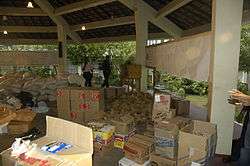Sarvodaya Shramadana Movement
The Sarvodaya Shramadana Movement is a self-governance movement in Sri Lanka, which provides comprehensive development and conflict resolution programs to villages. It is also the largest indigenous organization working in reconstruction from the tsunami caused by the 2004 Indian Ocean earthquake. Founded in 1958 by A. T. Ariyaratne when he took “forty high school students and twelve teachers from Nalanda College Colombo on “an educational experiment” to an outcaste village, Kathaluwa, and helped the villagers fix it up.







As of 2006, Sarvodaya staff people and programs are active in some 15,000 (of 38,000) villages in Sri Lanka. The organization estimates that 11 million citizens are individual beneficiaries of one of their programs. The group distributes funds from a financial reserve bank of 1.6 billion rupees.[1]
The Sarvodaya movement belongs to the Global Ecovillage Network [2].
Etymology
The movement is based on Buddhist and Gandhian principles. Coined by Mohandas Gandhi, the terms sarvodaya ('welfare for all'), and swaraj (self-governance). The word shramadana means 'gift of labor'[1]. Collectively, the name 'Sarvodaya Shramadana' means 'welfare for all through our shared labor'[3].[1]
History
In 1958, the neglected village of Rodiya, inhabited by social outcasts and beggars, received help in the form of renovating houses, digging wells and latrines, and establishing community gardens; educational programs and self-employment help were also launched. The organizer was D.A. Abeysekera, an employee of the Sri Lankan Department of Rural Development, who while searching for solutions for this kind of community coined the term Shramadana , meaning 'gift of labor', to describe the type of help expected from volunteers. The village of Kathaluwa was to be the first beneficiary of this joint work.
Ahangamage Tudor Ariyaratne, then a young teacher at Nalanda College in Colombo, led a group of teachers and students who participated in what he called an "educational experiment." The success of the "experiment", repeated in other villages, and developing independently from the Department of Rural Development, led to the creation of the largest development-promoting organization in Sri Lanka - The Sarvodaya Shramadana Movement .[4]
Ten basic needs
Activists led by Ariyaratne tried to meet the real needs of the villagers. To this end, they conducted research in 600 villages, asking residents to list their ten most important needs, in order from most urgent to least important. The survey resulted in a list of the following needs:[3]
- Clean environment
- Adequate supply of water
- Clothing
- Nutritious food
- Shelter
- Health care
- Communication
- Fuel and lighting (energy)
- Access to education
- Cultural and spiritual performance[5]
Program
The Sarvodaya program begins with an invitation from a village for discussion of what is needed and how it can be done. It proceeds in stages through creating a village council, building a school and clinic, setting up family programs, creating economic opportunity so that the village economy becomes self-sustaining, starting a village bank, and offering help to other villages. In addition, Sarvodaya sponsors public meditations in which tens and sometimes hundreds of thousands of Buddhists, Hindus, Muslims and Christians meditate together on each other's welfare, using the Buddhist Brahmavihara (sublime attitude) meditations, which are acceptable within all faiths.
Assistance deliberately begins with a change in the attitude of the villagers, and satisfying basic needs is only the third stage. The organization insists on understanding the real needs of a peaceful, sustainable society[6]. A.T. Ariyaratne emphasizes that Sarvodaya is about awakening both individuals and society[7].
The next five steps are[6]:
- Development of psychological infrastructure,
- Development of social and educational infrastructure,
- Satisfying basic human needs and institutional development,
- Income and job creation and self-sufficiency,
- Sharing with neighboring villages.
Fusion – Sarvodaya ICT4D Movement is the ICT for development (ICT4D) program. As a response to the emerging digital divide issues of rural Sri Lanka, Sarvodaya started setting up telecentres experimentally in 1997. This has led to the pioneering telecentre program in the country. Village Information Centres (popularly known as VICs) are rural libraries, set up by village youth leaders as 'Zero Cost' village initiatives, which prepare disadvantaged, less educated rural communities for the information age. Out of the 172 VICs initiated since early 2000, there are about 21 VICs graduated to their own forms of telecentres by mid-2008.
In September 2012, Etisalat Sri Lanka, a mobile telephony provider in cooperation with Sarvodaya-Fusion, opened Etisalat Android Village Hub . The program aims to connect rural communities using Android tablets, which the company distributed to 20 families in selected villages for a period of two weeks and conduct internet training[8].
Author John P. Clark has argued that the Sarvodaya Shramadana Movement are anarchist in their organisation and goals, noting their inspiration from the philosophical anarchist Mahatma Gandhi.[9]
Tsunami relief
On December 26, 2004, at 9am, waves flooded the fishing town of Hambantota. The director of one of the institutes for sustainable agriculture in Sarvodaya, Nandana Jayasinghe, was about an hour away from the tragedy, in Thanamalwila next to Udawalawe National Park. After 6 hours he arrived in the town with three 10-ton trucks full of food, water, blankets and other means of survival. In the following days he organized the next deliveries, temporary housing for the population and, along with other volunteers in the movement, helped clean up and reorganize the town after the tragedy. The movement participated in helping the region many years after the tsunami[10]. Tsunami destroyed 226 villages belonging to the Sarvodaya movement[11].
In total, the movement built 1104 houses, 5593 toilets, 2274 wells, 2450 waste composters, 185 water tanks and 85 playgrounds for the victims of the tsunami[10]. The Sarvodaya movement tried to get help from recipients themselves, in order that they feel responsible and take part in rebuilding their own lives[11].
See also
Notes
- Perry Garfinkel, Buddha or bust (2006), p. 110
- Ross Jackson (2004). "The Ecovillage Movement". Permaculture Magazine. Letter to. Retrieved 31 December 2012.
- Craig Mackintosh (September 21, 2009). "Letters from Sri Lanka - The Sarvodaya Shramadana Movement, and the Ten Basic Needs (part 2)". The Permaculture Research Institute of Australia. Retrieved January 2, 2013.
- Craig Mackintosh (13 September 2009). "Letters from Sri Lanka – Does Sarvodaya Hold the Secrets to Systemic Change? (part 1)". The Permaculture Research Institute of Australia.
- "Sarvodaya History and Philosophy". Sarvodayausa.org.
- Craig Mackintosh (December 5, 2009). "Letters from Sri Lanka - the Sarvodaya Shramadana Movement and the 'Third Way' (part 3)". Permaculture Research Institute USA. Retrieved January 1, 2013.
- "Sarvodaya: Building a Nonviolent and Cooperative World". Ahimsa Center. Retrieved January 1, 2013.
- "Etisalat partners Sarvodaya in rural development scheme". The Sunday Times. September 30, 2012. Retrieved December 31, 2012.
- Clark, John (2013). The Impossible Community: Realising Communitarian Anarchism. ISBN 9781441185471.
- Craig Mackintosh (December 18, 2009). "Letters from Sri Lanka - Sarvodaya Builds Community and National Resilience (part 4)". The Permaculture Research Institute of Australia. Retrieved January 1, 2013.
- "Lessons Learned". Sarvodaya.org. Retrieved January 2, 2012.
Further reading
- Ariyaratne, A. T. (1986). Asian values as a basis for Asian development. In D. C. Korten (Ed.), Community management: Asian experience and perspectives (pp. 32–39). West Hartford, CT: Kumarian Press.
- Ariyaratne, A. T. (1987). Beyond development communication: Case study on Sarvodaya, Sri Lanka. In N. Jayaweera & S. Amunugama (Eds.), Rethinking development communication (pp. 239–251). Singapore: Asian Mass Communication Research and Information Center.
- Ariyaratne, A. T. (1996). Gandhian philosophy and Sarvodaya approach to promote ethnic and racial harmony and economic equality. International Policy Review, 6(1), 122–126.
- Bond, G. D. (2004). Buddhism at work: Community development, social empowerment and the Sarvodaya movement. Bloomfield, CT: Kumarian Press.
- Dissanayake, W. (2014). Development and communication in Sri Lanka: A Buddhist approach. In M. K. Asante, Y. Miike, & J. Yin (Eds.), The global intercultural communication reader (2nd ed., pp. 467–479). New York, NY: Routledge.
- Macy, J. (1985). Dharma and development: Religion as resource in the Sarvodaya self-help movement (Rev. ed.). West Hartford, CT: Kumarian Press.
External links
- http://www.sarvodaya.org
- http://www.sarvodayausa.org
- http://www.sarvodayanepal.org
- http://www.sarvodaya.nl
- http://www.fusion.lk
- https://web.archive.org/web/20160303183259/http://sarvodayajapan.jimdo.com/
| Wikimedia Commons has media related to Sarvodaya. |